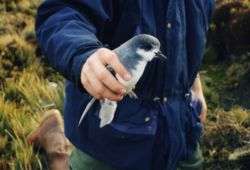Blue petrel
| Blue petrel | |
|---|---|
 | |
| In flight. | |
| Scientific classification | |
| Kingdom: | Animalia |
| Phylum: | Chordata |
| Class: | Aves |
| Order: | Procellariiformes |
| Family: | Procellariidae |
| Genus: | Halobaena Bonaparte, 1856 |
| Species: | H. caerulea |
| Binomial name | |
| Halobaena caerulea (Gmelin, 1789) | |
| Synonyms | |
|
Procellaria caerulea | |

The blue petrel (Halobaena caerulea) is a small seabird in the shearwater and petrel family Procellariidae. This small petrel is the only member of the genus Halobaena, but is closely allied to the prions.[3]
Taxonomy
The blue petrel is the only bird from the genus Halobaena, and a member of the Procellariiformes order. They share certain identifying features. First, they have nasal passages that attach to the upper bill called naricorns. The bills of Procellariiformes are unique in that they are split into between 7 and 9 horny plates. They produce a stomach oil made up of wax esters and triglycerides that is stored in the proventriculus. This is used against predators as well as an energy rich food source for chicks and for the adults during their long flights.[4] Finally, they also have a salt gland that is situated above the nasal passage and helps desalinate their bodies, due to the high amount of ocean water that they imbibe. It excretes a high saline solution from their nose.[5]
The word "petrel" is derived from Saint Peter and the story of his walking on water. This is in reference to the petrel's habit of appearing to run on the water to take off.[6]
Description
The blue petrel's plumage is white underneath and grey on its upper parts, with an "M" banding across its top, which is similar to the prion's. It also has a white-tipped tail. Its bill is smaller than prions.[3]
Behaviour
Feeding
They feed predominantly on krill, as well as other crustaceans, fish, and squid. They can dive up to at 6 m (20 ft).[3]
Breeding

The blue petrel like all members of the Procellariiformes are colonial, and have large colonies. Their nest is a burrow, and they lay one egg. Both parents incubate the egg for approximately 50 days and the chick fledges after 55 days. Skua are the main danger for their eggs and chicks.
Distribution and habitat
They inhabit the southern oceans ranging as far north as South Africa, Australia and portions of South America. Previously thought to only breed in a narrow latitudinal band from 47° to 56° S on either side of the Antarctic Polar Front. Nesting on subantarctic islands, such as Marion Island, the Crozet Islands, Kerguelen Islands, Macquarie Island, South Georgia, Prince Edward Island.[3]
In 2014 a breeding colony was discovered on Gough Island (40° S, 10° W), central South Atlantic Ocean, more than 700 km north of its known breeding range. Breeding here appears to take place later than at colonies farther south, although the discovery is recent it does not necessarily represent a recent range extension.[7]
Conservation
The blue petrel has a very large range and an estimate population of 3,000,000 adult birds and thus it is rated as Least Concern, by the IUCN.[1][8]
Footnotes
- 1 2 BirdLife International (2012). "Halobaena caerulea". IUCN Red List of Threatened Species. Version 2013.2. International Union for Conservation of Nature. Retrieved 26 November 2013.
- 1 2 3 Peters, James Lee (1931)
- 1 2 3 4 ZipCode Zoo (16 Jul 2009)
- ↑ Double, M. C. (2003)
- ↑ Ehrlich, Paul R. (1988)
- ↑ Gotch, A. T. (1995)
- ↑ Ryan, P.G., B.J. Dilley, C.W. Jones, and A.L. Bond. 2015. Blue Petrels Halobaena caerulea discovered on Gough Island. Ostrich 86: 193-194. DOI: 10.2989/00306525.2015.1005558
- ↑ BirdLife International (2009)
References
- BirdLife International (2009). "Blue Petrel Halobaena caerulea - BirdLife Species Factsheet". Data Zone. Retrieved 22 Jul 2009.
- Brands, Sheila (14 Aug 2008). "Systema Naturae 2000 / Classification - Genus Halobaena-". Project: The Taxonomicon. Retrieved 22 Jul 2009.
- Brooke, M. (2004). "Procellariidae". Albatrosses And Petrels Across The World. Oxford, UK: Oxford University Press. ISBN 0-19-850125-0.
- Double, M. C. (2003). "Procellariiformes (Tubenosed Seabirds)". In Hutchins, Michael; Jackson, Jerome A.; Bock, Walter J.; Olendorf, Donna. Grzimek's Animal Life Encyclopedia. 8 Birds I Tinamous and Ratites to Hoatzins. Joseph E. Trumpey, Chief Scientific Illustrator (2nd ed.). Farmington Hills, MI: Gale Group. pp. 107–111. ISBN 0-7876-5784-0.
- Ehrlich, Paul R.; Dobkin, David, S.; Wheye, Darryl (1988). The Birders Handbook (First ed.). New York, NY: Simon & Schuster. pp. 29–31. ISBN 0-671-65989-8.
- Gotch, A. F. (1995) [1979]. "Albatrosses, Fulmars, Shearwaters, and Petrels". Latin Names Explained A Guide to the Scientific Classifications of Reptiles, Birds & Mammals. New York, NY: Facts on File. pp. 191–192. ISBN 0-8160-3377-3.
- Peters, James Lee (1931). Checklist of Birds of the World. 1. Cambridge, MA: Harvard University Press.
- ZipCode Zoo (19 Jun 2009). "Halobaena (Genus)". BayScience Foundation. Archived from the original on 2012-06-09. Retrieved 22 Jul 2009.
External links
- Blue petrel on Birdlife International
- Blue petrel on ZipcodeZoo
- Blue petrel Photos
- Stamps (for French Southern and Antarctic Territory, South Georgia and the South Sandwich Islands)
- Blue petrel videos on the Internet Bird Collection
- Blue petrel photo gallery VIREO
